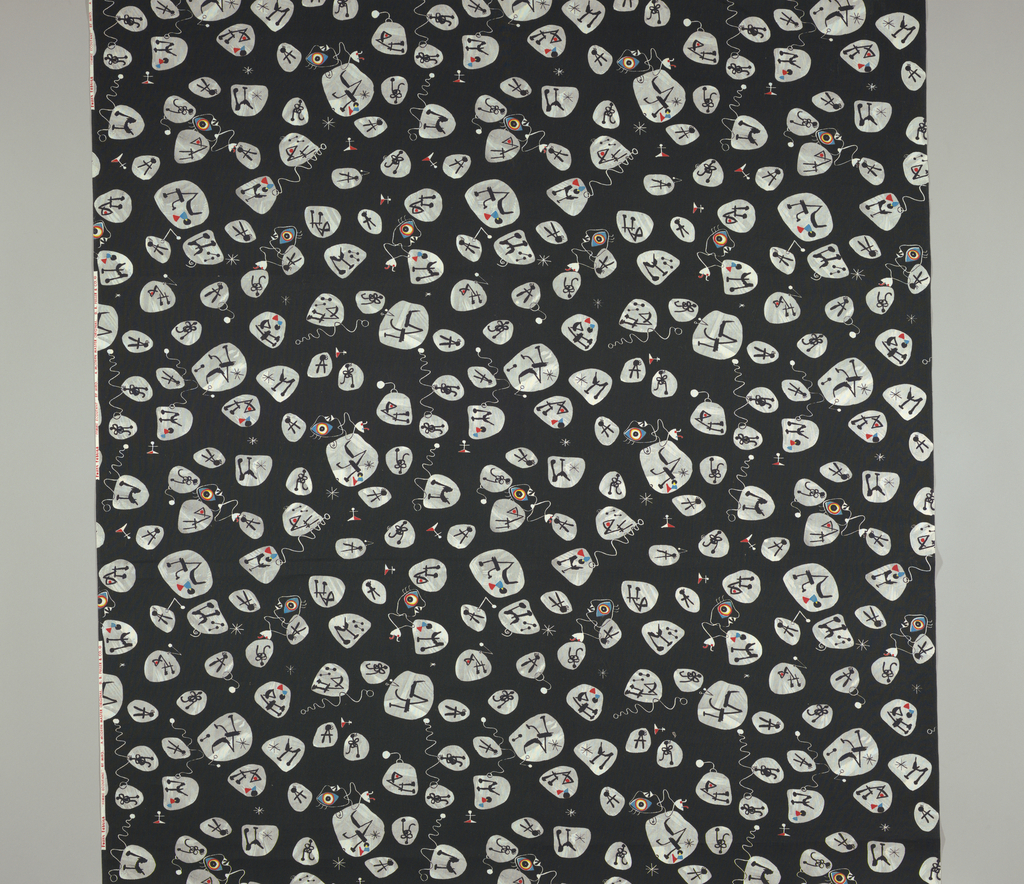In 1953, Dan Fuller, president of Fuller Fabrics, invited five of the 20th century’s most distinguished artists: Pablo Picasso, Fernand Léger, Marc Chagall, Joan Miró, and Raoul Dufy, to collaborate on a line of textiles to be called the Modern Master Series. The concept was unique in that the artists were not commissioned to produce original patterns specifically for the textiles. Instead, Fuller worked with each artist to select motifs from their existing body of work, which were then translated by the company’s in house designers into repeating patterns.[1] Fidelity of reproduction was essential, and Fuller’s designers worked diligently to render the motifs accurately for engraving. The patterns were roller printed rather than screen printed, because the fabric was intended to be mass produced and sold at low price points—less than $2 a yard—for use by both garment manufacturers and home sewers. Each artist approved the final patterns derived from his work and was involved in the selection of the colors.
Marketing was a key element of the project. The Modern Master Series was launched in the fall of 1955 with both a museum exhibition as well as a documentary film that featured the artists in their studios, the original works of art, the finished fabrics, and the production process. The exhibition and film opened at the Brooklyn Museum and then traveled to other American museums.[2] For a five-page editorial spread in Life magazine, “Modern Art in Fashion,” Life’s fashion editor, Sally Kirkland, enlisted the participation of her friend, fashion designer Claire McCardell. McCardell designed a wardrobe of separates and dresses using Modern Master fabrics, which were featured in the Life photo essay.[3]
The collection of 60 designs was much celebrated when it was launched. American Fabrics applauded Fuller for its daring and courage in bridging “the abyss” between fine and applied arts.[4] Cooper Hewitt holds six fabrics from Fuller’s Modern Master Series in its collection: The Bullfight, Birds, and Poisson by Picasso; Vitrail by Léger; Femme Ecoutant by Miró; and Evening Enchantment by Chagall. A seventh fabric, Leger’s Parade Sauvage came in the form of a dress by Claire McCardell (American, 1905–1958) and was acquired in 2013 (2013-5-1).
The source motifs for this pattern are taken from a 1945 oil painting by Miró, Woman Hearing Music (Femme entendant de la musique), and they are readily recognizable as the highly imaginative pictograms characteristic of Miró’s work. In adapting Miró’s work for the printed fabric, Fuller’s designers did not maintain the painting’s original arrangement of the motifs. Instead, they reconfigured them to create a more complex pattern with a very different effect. Each pictogram, which appears only once in the painting, appears multiple times in each textile pattern repeat, rotated and/or reversed, so there is no longer a clear top, bottom, right, or left to the composition. On the textile, the pictograms appear to be floating in space, an effect amplified by the fabric’s black background. Miró’s surreal figures are particularly well-suited to this type of directionless arrangement.
While it may be hard to imagine that Fuller’s designers could have improved on Miró’s masterpiece, the reconfiguration of the pictograms is more effective as a textile pattern than a faithful reproduction of the original painting would have been.
[1] Geoffrey Rayner, Richard Chamberlain and Annamarie Stapleton, Artists’ Textiles: Artist Designed Textiles 1940–1976 (Woodbridge: Antique Collectors’ Club, 2012), 139.
[2] “Trying abstraction on fabrics; adaptations from Picasso, Miro, and Léger.” Artnews 54, (November 1955): 43.
[3] Kohle Yohannan, and Nancy Nolf, Claire McCardell: Redefining Modernism (New York: Harry N. Abrams, 1998), 126.
[4] “Fine arts and textiles come to terms.” American Fabrics no. 35 (January 4, 1955): 49.
Maleyne M. Syracuse is President of the Board of Directors of Peters Valley School of Craft, a former Treasurer of the Textile Society of America, and an independent art historian. She is a graduate of the Masters program in the History of Decorative Arts at Cooper Hewitt, Smithsonian Design Museum/Parsons The New School for Design.
